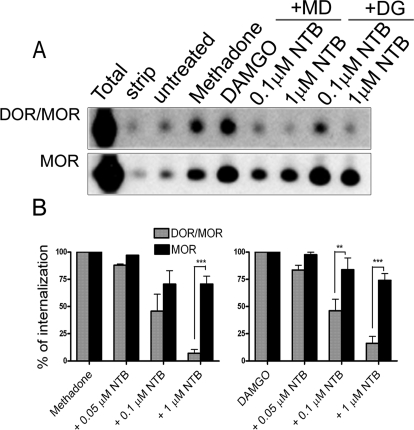Fig. 3.
Endocytosis of the DOR/MOR heteromer can be inhibited by NTB in a dose-dependent manner. A, endocytosis of DOR/MOR heteromers and MOR homomers was analyzed by biotin protection endocytosis assay in cells coexpressing FLAG-MOR and HA-DOR. Cells were biotinylated then pretreated with different concentrations of NTB (or left untreated) for 20 min as indicated. Next, cells were treated with 1 μM methadone (MD) or DAMGO (DG) for an additional 30 min. Endocytosed protected receptors were separately resolved by SDS-PAGE as two populations, MOR homomers and DOR/MOR heteromers, after serial immunoprecipitation (see Materials and Methods). Total refers to the biotinylated receptor signal present in cells after initial labeling and without further manipulation; strip refers to biotinylated cells that were reacted with glutathione without other manipulations, demonstrating the efficiency with which biotin was cleaved from receptors and represents the background. Both total and strip serve as internal controls within each experiment. A representative immunoblot is shown for DOR/MOR heteromers (top) and MOR homomers (bottom). B, quantification of multiple experiments performed as in A. Histogram shows the endocytosis produced in the presence of antagonist as a percentage of that produced with methadone or DAMGO alone. Shown are the mean ± S.E.M. of n = three to five independent experiments (two-way ANOVA, Bonferroni post-test: **, p < 0.01; ***, p < 0.001).

